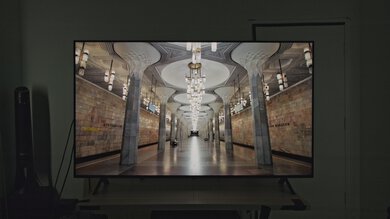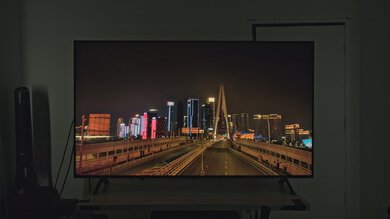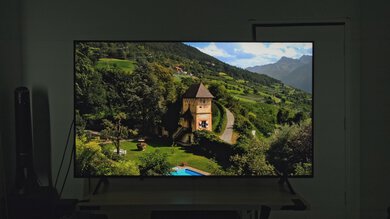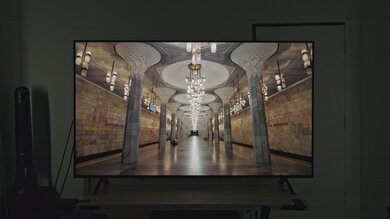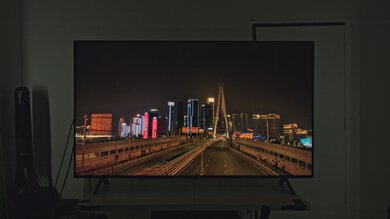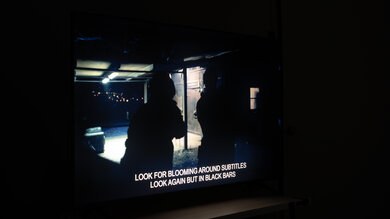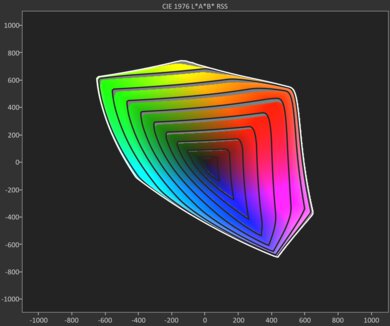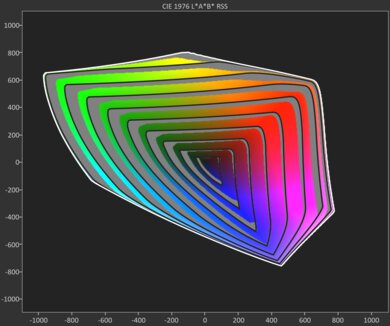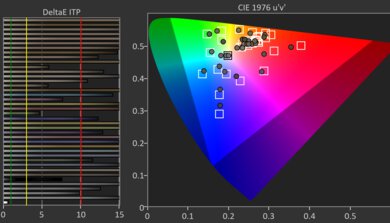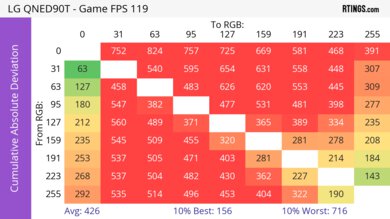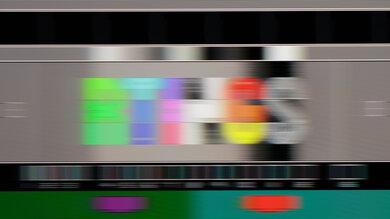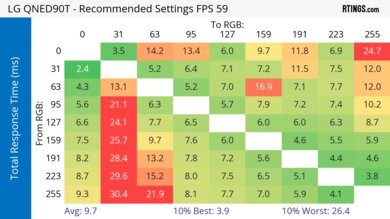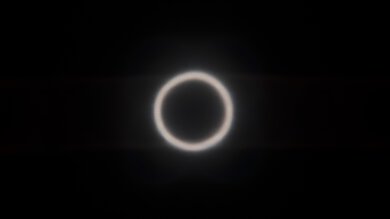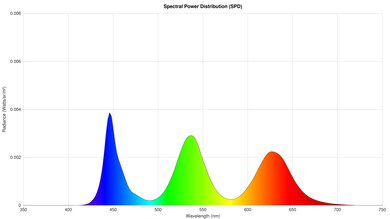The LG QNED90T is an upper mid-range TV released in 2024 and replaces the LG QNED90. It's part of LG's QNED lineup, sitting above the LG QNED85T and the LG QNED80T. The TV is LG's highest-tier offering in their 4k Mini LED lineup and only sits below the 8k LG QNED99T. It's packed with modern gaming features like HDMI 2.1 bandwidth on all four ports, 4k @ 120Hz, and VRR. It also supports Dolby Vision and DTS audio formats and has Multi View. It uses LG's α8 AI Processor 4K, which can automatically adjust picture settings based on the type of content you're watching. The TV uses the 2024 version of LG's webOS interface, which is loaded with apps and offers smart features like voice control, and it comes with LG's popular Magic Remote. It has a built-in 40W 2.2 channel speaker system. We bought and tested the 65-inch model, but it's available in three sizes total: 65-inch, 75-inch, and 86-inch.
Our Verdict
The LG QNED90T is decent for mixed usage. It looks good in both dark rooms and bright ones, since it has good black levels and vibrant colors, but some will be put off by the noticeable blooming around highlights and its inability to reduce the intensity of direct reflections. Its HDR brightness is decent enough for movies and show to be impactful, but it loses a lot of brightness in HDR while using the Game Optimizer. Speaking of gaming, the TV has modern gaming features and low input lag, but its pixel transitions are incredibly slow, which leads to blurry motion that looks bad. If you're looking for a TV to watch content with a group of friends, you can do better since it has a narrow viewing angle.
Great SDR brightness helps it fight glare from indirect lighting.
Good upscaling.
Most colors are vibrant and lifelike.
Effective local dimming for deep blacks.
- Game Optimizer has more blooming and isn't as bright in HDR as other picture modes.
Noticeable blooming around subtitles and highlights.
Does a poor job handling reflections.
The LG QNED90T is good for a home theater. It has good black levels, so blacks are deep most of the time, but there's some apparent blooming around subtitles and highlights, which does lessen the impact of scenes that have a mix of bright and dark elements. The TV's color volume in HDR is very good, so you get vibrant colors. However, its accuracy in HDR with colors and brightness is only alright. Inversely, the TV has excellent accuracy in SDR, but its color volume is only decent. However, it's still good enough for vibrant colors in most SDR content. The TV does a good job upscaling lower-resolution content, but low-bitrate content isn't smoothed out enough to eliminate artifacts. There's some minor stutter that's visible during slower camera movements, but not everyone will even notice this.
Good upscaling.
Most colors are vibrant and lifelike.
Barely any banding in color gradients.
Effective local dimming for deep blacks.
Excellent SDR pre-calibration accuracy.
Noticeable blooming around subtitles and highlights.
Brightness in HDR content doesn't follow the filmmaker's intent.
Only okay low-quality content smoothing leads to visible artifacts.
Color accuracy in HDR is only okay.
The LG QNED90T is good for a bright room overall. Blacks remain deep and colors stay vibrant in a bright room, which is great. The TV has great SDR brightness which helps it fight glare from indirect light sources. However, it has poor direct reflection handling, so any light placed opposite the screen is very distracting.
Great SDR brightness helps it fight glare from indirect lighting.
Blacks stay deep and colors stay vibrant in a bright room.
Does a poor job handling reflections.
The LG QNED90T is good for sports. It has great SDR brightness, so it fights glare from indirect light sources, but reflections caused by direct light sources placed opposite the screen are distracting. Colors are good enough in SDR to enjoy a pleasant viewing experience, and they're accurate, which is great if you care about your team's jersey looking the way it should. The TV does a good job of upscaling low-resolution content, so the big game doesn't look overly soft. However, there are still noticeable artifacts in cable broadcasts and low-quality streams. Motion is mostly clear, but there's some blur behind quick motion in fast-paced sports like racing. The TV's gray uniformity is passable, but you still see some dirty screen effect towards the middle of the screen when watching certain sports, like hockey. The TV's viewing angle is unremarkable, so it's best to keep yourself centered to screen for the best possible image.
Great SDR brightness helps it fight glare from indirect lighting.
Good upscaling.
Only okay low-quality content smoothing leads to visible artifacts.
Does a poor job handling reflections.
The LG QNED90T is adequate for gaming. It has HDMI 2.1 bandwidth, 4k @ 120Hz, and VRR, making it fully compatible with modern consoles. However, it loses a lot of HDR brightness in its Game Optimizer picture mode, which affects the impact of HDR games. It has low input lag, especially at 120Hz, so gaming feels responsive. Unfortunately, its pixel transitions are incredibly slow, so fast motion is blurry and looks pretty bad, which is a major drawback.
HDMI 2.1 bandwidth, up to 4k @ 120Hz, and VRR support.
Most colors are vibrant and lifelike.
Effective local dimming for deep blacks.
Very low input lag at 120Hz for a responsive feel.
- Game Optimizer has more blooming and isn't as bright in HDR as other picture modes.
Noticeable blooming around subtitles and highlights.
Incredibly slow pixel transitions leads to very blurry motion while gaming.
The LG QNED90T has good brightness overall. Its SDR brightness is great, which helps it fight glare in a bright room. The TV's HDR brightness is only decent, but it's still good enough for highlights to stand out well during darker scenes.
Great SDR brightness helps it fight glare from indirect lighting.
The LG QNED90T has good black levels overall. With local dimming enabled, blacks are deep and uniform. However, there's noticeable blooming around highlights and subtitles, which affects how deep blacks look during scenes that have a mix of dark and bright elements on the screen.
Effective local dimming for deep blacks.
Noticeable blooming around subtitles and highlights.
The LG QNED90T has good colors. Its HDR color volume is very good, so colors are vibrant in HDR. Its SDR color volume is decent, but it does struggle more with displaying lighter shades. Still, it's good enough for most SDR content. The TV has excellent accuracy in SDR, but its HDR accuracy is only okay, so colors don't quite look the way they should in HDR content.
Most colors are vibrant and lifelike.
Excellent SDR pre-calibration accuracy.
Color accuracy in HDR is only okay.
Note: We're in the process of improving our tests related to image processing, but this score should give you a general idea of how a TV performs overall with its image processing capabilities.
The LG QNED90T has decent processing. Color gradients have barely any banding in them, so scenes with nuanced shades of the same color next to each other look smooth. The TV does a good job of upscaling low-resolution content, which leads to an image that doesn't look too soft. Unfortunately, there are still some artifacts present in heavily compressed content since the TV only has okay low-quality content smoothing. Its PQ EOTF tracking is alright, but some HDR scenes are too bright while others are too dark.
Good upscaling.
Barely any banding in color gradients.
Brightness in HDR content doesn't follow the filmmaker's intent.
Only okay low-quality content smoothing leads to visible artifacts.
The LG QNED90T has sub-par responsiveness in the Game Optimizer mode. It has HDMI 2.1 bandwidth for up to 4k @ 120Hz with VRR, and you get low enough input lag for a responsive feel. Unfortunately, this TV had bad pixel transitions; they're so slow that fast motion is very blurry, which is distracting and really holds back the TV's usefulness for gamers.
HDMI 2.1 bandwidth, up to 4k @ 120Hz, and VRR support.
Very low input lag at 120Hz for a responsive feel.
Incredibly slow pixel transitions leads to very blurry motion while gaming.
We're in the process of fixing the way we evaluate a TV's overall motion handling. This section is currently broken, and the score isn't indicative of how well a TV handles motion overall.
Performance Usages
Changelog
- Updated May 08, 2025: Converted to Test Bench 2.0.1. We did this to fix an issue with our scoring in the Supported Resolutions section, since TVs with a refresh rate higher than 144Hz were being penalized for not supporting 144Hz.
- Updated Apr 11, 2025:
We wrote text for the new tests and rewrote text throughout the review after updating pre-existing tests and scores for Test Bench 2.0.
- Updated Apr 11, 2025: We converted the review to Test Bench 2.0. With this new methodology, we've added new tests to expand the scope of our testing, adjusted our scoring to better align with current market conditions, and added performance usages that group related tests together to give more insight into specific aspects of a TV's performance. You can find a full list of changes in the TV 2.0 changelog.
- Updated Oct 16, 2024: Mentioned the newly-reviewed Panasonic Z85A OLED in the Blooming section of this review.
Check Price
Differences Between Sizes And Variants
We bought and tested the 65-inch LG QNED90T, and the results are also valid for the 75-inch model. The 86-inch model uses an IPS panel, so it performs a bit differently than the other sizes, with worse contrast but a better viewing angle. Internationally, the TV is known as the LG QNED91T, and we expect most of our results to be valid for that model as well. The Costco variant carries the suffix 'AUS,' supports Wi-Fi 6E (the TUA variant has Wi-fi 5), and comes with store-specific perks, like extended warranties.
| Size | US Model | Panel Type | Costco Variant |
|---|---|---|---|
| 65" | 65QNED90TUA | VA | - |
| 75" | 75QNED90TUA | VA | 75QNED90TAA.AUS |
| 86" | 86QNED90TUA | IPS | 86QNED90TAA.AUS |
Our unit was manufactured in March 2024.
Popular TV Comparisons
The LG QNED90T is a decent TV overall. It has pretty good picture quality, but it has poor reflection handling, and it has very blurry motion while gaming due to its incredibly slow pixel transitions. Outside of that, it doesn't have any glaring issues, but it doesn't really excel in any way and doesn't do anything that separates it from the crowd of Mini LEDs. For less money, you can get much better overall Mini LED TVs like the Hisense U8/U8N and the TCL QM8/QM851G QLED. For around the same cost, you can even get an LG OLED TV like the LG B4 OLED. For those reasons, it's a hard TV to recommend.
For more options, check out our recommendations for the best TVs for bright rooms, the best TVs for gaming, and the best TVs.
The LG C4 OLED is better than the LG QNED90T. The C4 is an OLED, so it displays deeper blacks with no blooming at all. The C4 follows the PQ EOTF curve closer and has better color accuracy, so it's the more accurate TV overall. The C4 also has a faster response time for less blur behind fast motion, a wider viewing angle, and better image processing.
The Samsung QN90D is better overall than the LG QNED90T. With local dimming enabled, the Samsung has better contrast for deeper blacks in a dark room, with less noticeable blooming. The Samsung has better reflection handling and gets a lot brighter in SDR, so it overcomes more glare in very bright rooms. It also gets brighter in HDR and has better PQ EOTF tracking, so it displays brighter highlights and is more accurate in HDR. Finally, the Samsung has a maximum refresh rate of 144Hz (120Hz on the LG), so it's better for PC gamers with high-end graphics cards, and its quicker pixel transitions means there's less blur behind fast motion.
The LG B4 OLED provides better picture quality than the LG QNED90T. The B4 has better color accuracy and PQ EOTF tracking, so it's the more accurate TV overall. The B4 also has a quicker response time for less blur behind fast motion and lower input lag, so it's the better TV for gaming. Additionally, the B4 has better contrast that provides inky blacks, and its wide viewing angle makes it more suitable for use in a group setting.
The Hisense U8N is better than the LG QNED90T. The Hisense has better contrast, so it displays deeper blacks that are approaching what you get from an OLED. The Hisense is the brighter TV overall, so it displays brighter highlights in HDR and overcomes more glare in a bright room. When it comes to colors, the Hisense has the edge due to its wider color gamut and better color volume. The Hisense also has a faster response time and supports 144Hz, so it's the better option for most gamers.
Test Results

The LG QNED90T has decent HDR brightness, so highlights stand out well during darker scenes. Combined with its great contrast, this TV provides a good HDR viewing experience.
These measurements are after calibrating the HDR white point with the following settings:
- HDR Picture Mode: FILMMAKER Mode
- Local Dimming: Low
- Brightness: 100
- Contrast: 100
- Color Temperature: Warm 50
Results with local dimming on 'Medium':
- Hallway Lights: 506 cd/m²
- Yellow Skyscraper: 299 cd/m²
- Landscape Pool: 182 cd/m²
Results with local dimming on 'High':
- Hallway Lights: 512 cd/m²
- Yellow Skyscraper: 216 cd/m²
- Landscape Pool: 169 cd/m²
The TV is noticeably dimmer in Game Optimizer. It's still bright enough for a solid HDR gaming experience, but the loss of brightness is a bit disappointing.
These measurements are after calibrating the HDR white point with the following settings:
- HDR Picture Mode: Game Optimizer
- Local Dimming: Low
- Brightness: 100
- Contrast: 100
- Color Temperature: Warm 50
The LG QNED90T has great SDR brightness, and it overcomes glare from indirect lighting.
These measurements are after calibration with the following settings:
- Picture Mode: Expert (Dark Space, night)
- Brightness: 100
- Contrast: 80
- Local Dimming: High
- Color Temperature: Warm 50
The LG QNED90T has very good contrast. Its native contrast is good, but with local dimming enabled, the TV displays very deep blacks that mostly stay deep when brighter highlights are also on screen.
The contrast and brightness of the TV are affected by which setting you use for local dimming. For HDR content, the default setting is 'Low' in the accurate picture modes since it tracks the PQ EOTF the best. However, with SDR content, setting local dimming on 'Low' results in a dimmer image than when it is on 'High.' The 'Medium' setting is essentially just a compromise between the other two options. Our results are with local dimming on 'High,' but you can see the contrast ratio with different settings below.
- Low: 89378:1
- Medium: 114971:1
The TV has only okay lighting zone precision. Unfortunately, there's visible blooming around bright highlights or text when they're against a black background, making blacks look less deep. The blooming performance is different depending on the local dimming setting and the picture mode. You can see the results below.
- Expert (Dark Space, night): LD set to 'Low'
- Expert (Dark Space, night): LD set to 'Medium'
- Game Optimizer: LD set to 'Low'
- Game Optimizer: LD set to 'Medium'
- Game Optimizer: LD set to 'High'
If you want a TV with no blooming at all, check out an OLED like the Panasonic Z85A OLED.
The TV has decent overall lighting zone transitions, but it struggles with fast-moving content. There's noticeable haloing, and the leading edge of bright, quick-moving objects is visibly dimmer. The TV performs differently depending on the local dimming setting and the picture mode. You can see the results below.
- Expert (Dark Space, night): LD set to 'Low'
- Expert (Dark Space, night): LD set to 'Medium'
- Game Optimizer: LD set to 'Low'
- Game Optimizer: LD set to 'Medium'
- Game Optimizer: LD set to 'High'
- Game Optimizer (VRR): LD set to 'Low'
- Game Optimizer (VRR): LD set to 'Medium'
- Game Optimizer (VRR): LD set to 'High'
The TV has decent SDR color volume. It has very good coverage of the DCI-P3 color space, but its coverage does decrease as colors get lighter. It has mediocre coverage of the wider BT.2020 color space, where it also struggles most with light shades.
| Volume ΔE³ | DCI-P3 Coverage | BT.2020 Coverage |
|---|---|---|
| L10 | 92.66% | 67.95% |
| L20 | 93.45% | 67.85% |
| L30 | 92.71% | 67.34% |
| L40 | 91.29% | 67.54% |
| L50 | 89.68% | 66.94% |
| L60 | 87.68% | 64.14% |
| L70 | 85.18% | 55.41% |
| L80 | 84.97% | 53.07% |
| L90 | 84.95% | 53.13% |
| L100 | 82.98% | 55.90% |
| Total | 87.70% | 60.45% |
The LG QNED90T has very good HDR color volume. Dark saturated colors are displayed well due to the TV's very good contrast. It also displays a wide range of colors at high luminance levels.
The LG QNED90T has excellent pre-calibration SDR accuracy. Blues are underrepresented in brighter shades of gray, which makes the TV's color temperature a bit too warm. Gamma is close to 2.2, but very dark and very bright scenes are displayed brighter than intended. Colors are mostly accurate across the board, with only some minor inaccuracies with reds, cyans, and whites.
The TV has fantastic SDR accuracy after calibration, and it's easy to calibrate. Gamma, white balance, and color temperature are now all essentially perfect. Color accuracy is outstanding, but there are still some very minor inaccuracies with some saturated reds.
See our full calibration settings.
The TV has okay accuracy in HDR before calibration. There's too much blue and not enough red in certain shades of gray, which makes the TV's color temperature noticeably cooler than 6,500K. Unfortunately, the accuracy of colors is unremarkable, with most colors being undersaturated and off target.
The LG QNED90T has alright PQ EOTF tracking. With content mastered at 600 and 1000 nits, some shadows are darker than intended, and some mid-tones and highlights are brighter than intended. With content mastered at 4000 nits, the highlights are more accurate, and there's a gradual roll-off to maintain detail in highlights that are brighter than what the TV is capable of.
The TV does a good job at upscaling low-resolution content like DVDs or lower-resolution streams. Details are clear enough, but finer details are hard to make out.
Sharpness processing was calibrated with no over-sharpening for low-resolution content, with the following settings:
- Sharpness: 16
- Super Resolution: High
The LG QNED90T has great HDR native gradient handling. There's no banding in brighter reds, and all other colors have very minimal banding that's only noticeable if you're specifically looking for it.
The LG QNED90T has low input lag when set to Game Optimizer with 'Prevent Input Delay' set to 'Boost,' resulting in a very responsive gaming experience.
The TV supports all common formats. It displays chroma 4:4:4 properly, which is important for clear text from a PC.
There are two settings you can use to passthrough proper chroma 4:4:4. The first is to change the input label to 'PC.' The second is to enable the '4:4:4 Passthrough' setting in the 'HDMI Settings' menu. Both of these options work the same and lock you out from using the 'Noise Reduction,' 'MPEG Noise Reduction,' 'Smooth Gradation,' and 'Real Cinema' settings.
The TV supports FreeSync and HDMI Forum VRR. It's also G-SYNC compatible, ensuring a nearly tear-free gaming experience from any VRR-enabled source.
It's fully compatible with everything the PS5 offers, like 1440p @ 120Hz and 4k @ 120Hz, as well as HDMI Forum VRR. It also supports Auto Low Latency Mode, so you don't have to worry about switching to Game Optimizer to get the lowest input lag.
It's fully compatible with everything the Xbox Series X|S offers, including 1440p @ 120Hz, 4k @ 120Hz, HDMI Forum VRR, FreeSync Premium Pro, and Dolby Vision gaming. It also supports Auto Low Latency Mode, so you don't have to worry about switching to Game Optimizer to get the lowest input lag.
Due to the TV's quick response time, there's some stutter when watching movies or TV shows, and it's most apparent in slow panning shots.
The TV removes judder when watching 24p movies or TV shows when the Real Cinema setting is enabled, even from sources that can only send a 60Hz signal, like a cable box.
The TV uses pulse width modulation (PWM) to dim its backlight, which introduces flicker that can bother people who are sensitive to it. The amount of flicker depends on the picture mode the TV is set to. In 'FILMMAKER' and 'Expert (Dark Space, night)' modes, the TV flickers at a fast 960Hz with the brightness set below maximum, but it flickers at 120Hz in those modes with local dimming on 'High.' All other picture modes flicker at 120Hz below maximum brightness. Fortunately, the TV is flicker-free in all picture modes, with the brightness set to maximum.
The TV has an optional backlight strobing feature, commonly known as black frame insertion. This feature is meant to reduce persistence blur and improve the appearance of motion. It works at both 60Hz and 120Hz, but there's apparent image duplication.
This TV has an optional motion interpolation feature to improve the clarity of motion. With slower moving scenes, it works okay, with only some artifacts around characters and objects. Unfortunately, it really struggles with faster-moving scenes, and there are distracting artifacts and haloing around characters.
The TV has poor direct reflection handling, since it barely reduces the intensity of direct light sources. If you have lamp, wall light, window, or other lighting placed opposite the screen, its reflection is very visible.
The TV has outstanding black levels in a bright room, so you get similarly deep blacks as you do with the lights off.
Colors stay well-saturated in a bright room, so you still get a vibrant viewing experience with the lights turned on.
The LG QNED90T has an unremarkable viewing angle, so it's not suitable for a wide seating arrangement. As you move off-center, there's significant gamma shifting, color shifting, and brightness loss, and colors look increasingly washed out as you move further away to the sides.
The TV uses a BGR (Blue-Green-Red) subpixel layout instead of the traditional RGB layout. This doesn't cause any issues for video or gaming content, but it can be a problem for PC monitor use as it impacts the text clarity, although not everyone will notice this.
The TV uses quantum dot color converters to produce red and green light, so colors are well separated with good purity.
Note that the 86-inch model uses an IPS panel with an RGB subpixel layout.
The LG QNED90T supports the full 48 Gbps bandwidth of HDMI 2.1 on all four HDMI ports. This allows you to take full advantage of multiple high-bandwidth devices, like if you own both current-gen consoles and a high-end gaming PC.
The TV supports eARC, which lets you pass high-quality, uncompressed audio to a compatible receiver or soundbar through an HDMI cable. It supports all major audio formats, so you don't have to worry about compatibility with external sources.
The LG QNED90T has a very similar design to the LG QNED90. It has thin bezels on three sides, which are barely noticeable when watching TV, and a thicker bottom bezel. It's not quite as nice looking as LG's OLED TVs, but it still looks premium overall.
The TV comes with two metal feet that can be adjusted into two different positions. The narrow position (pictured above) brings the feet close together, which is great if you have limited space on your table for the TV. The wide position has more stability and works well if you need to fit a soundbar in between the two feet. The feet lift the TV about 3.35 inches above the table, so pretty much any soundbar fits underneath without blocking the screen.
Footprint of the 65-inch stand in the narrow position: 16.6" x 11.77".
Footprint of the 65-inch stand in the wide position: 45.9" x 11.77".
The back of the TV is mostly made of metal. Most of the inputs are on the far left side of the TV when facing the front, so they're accessible if you have the TV wall-mounted. There are plastic clips on each side of the back, and the feet each have a slot that can be used to help with cable management. Unfortunately, the top of the back of our unit is warped near the VESA mounting points.
The TV runs the 2024 version of LG's proprietary smart interface, webOS. The interface is fast and easy to use, and it supports user profiles, so you can customize the home page for different users.
Unfortunately, the TV has a bug that sometimes causes it to not properly switch out of the Game Optimizer setting, so you're locked out of settings that should be available in other picture modes. To fix this, you can turn the TV off/on or change the input label a few times. When you do this and switch to a different picture setting, everything works as it should.
There are two settings in the 'Home Settings' menu, namely the 'Home Promotion' and 'Content Recommendation' settings. These settings remove the top banner ads and suggested content from the home screen. This gives your home screen a clean look, but there's no way to remove ads from the apps page.
The TV has a decent frequency response. It produces a bit of bass. Dialogue is clear and easy to understand at most volume levels. Unfortunately, the sound becomes unbalanced near and at its maximum volume.

